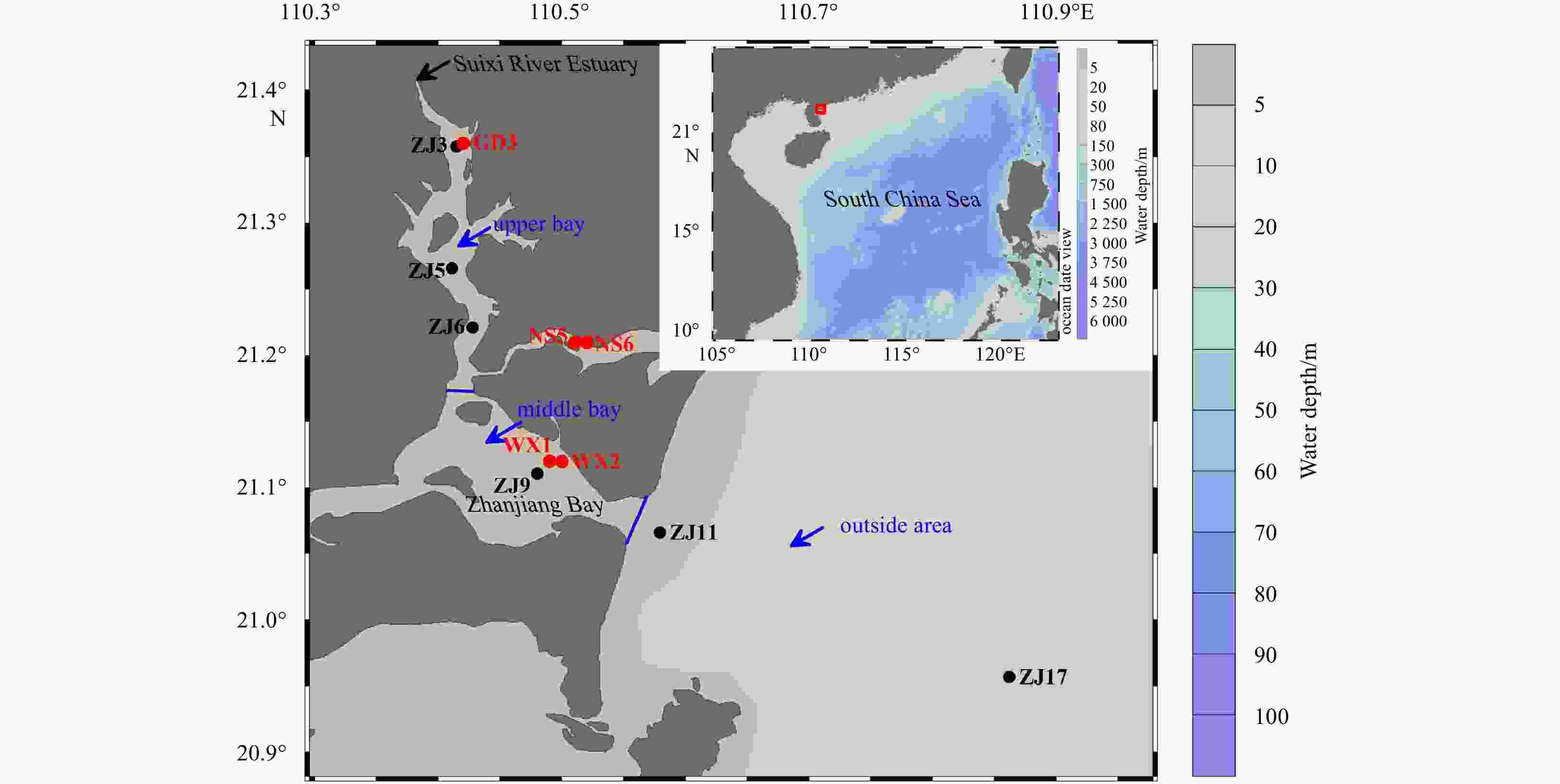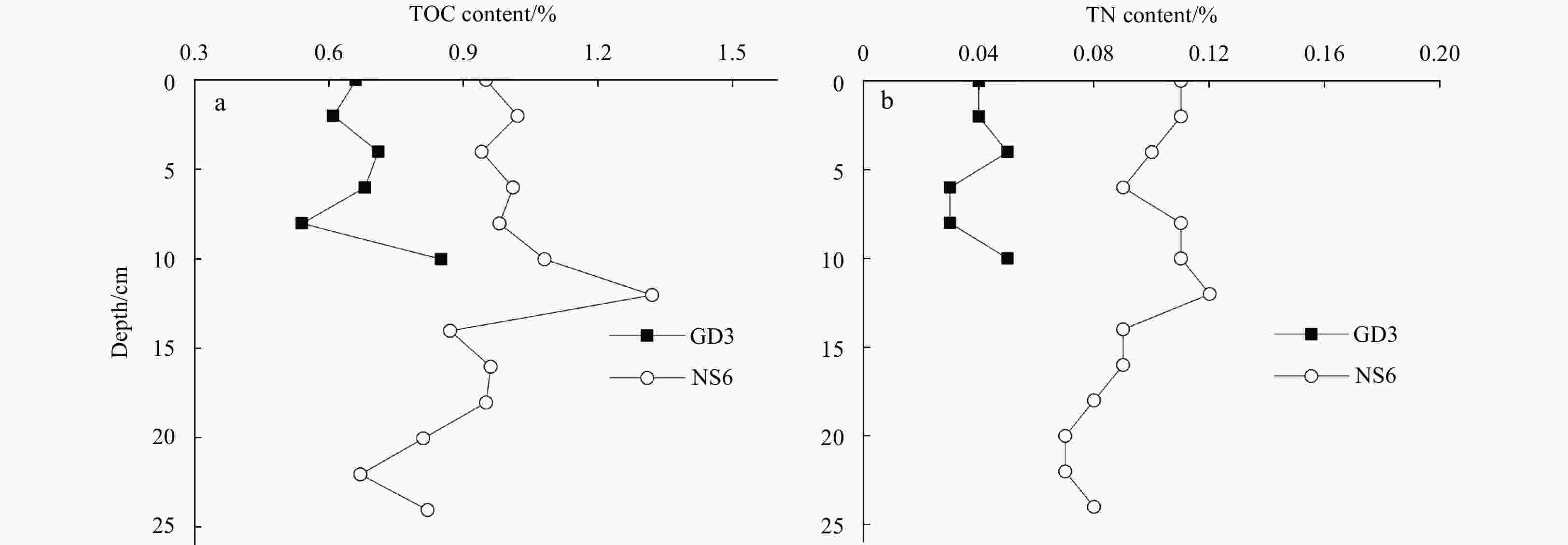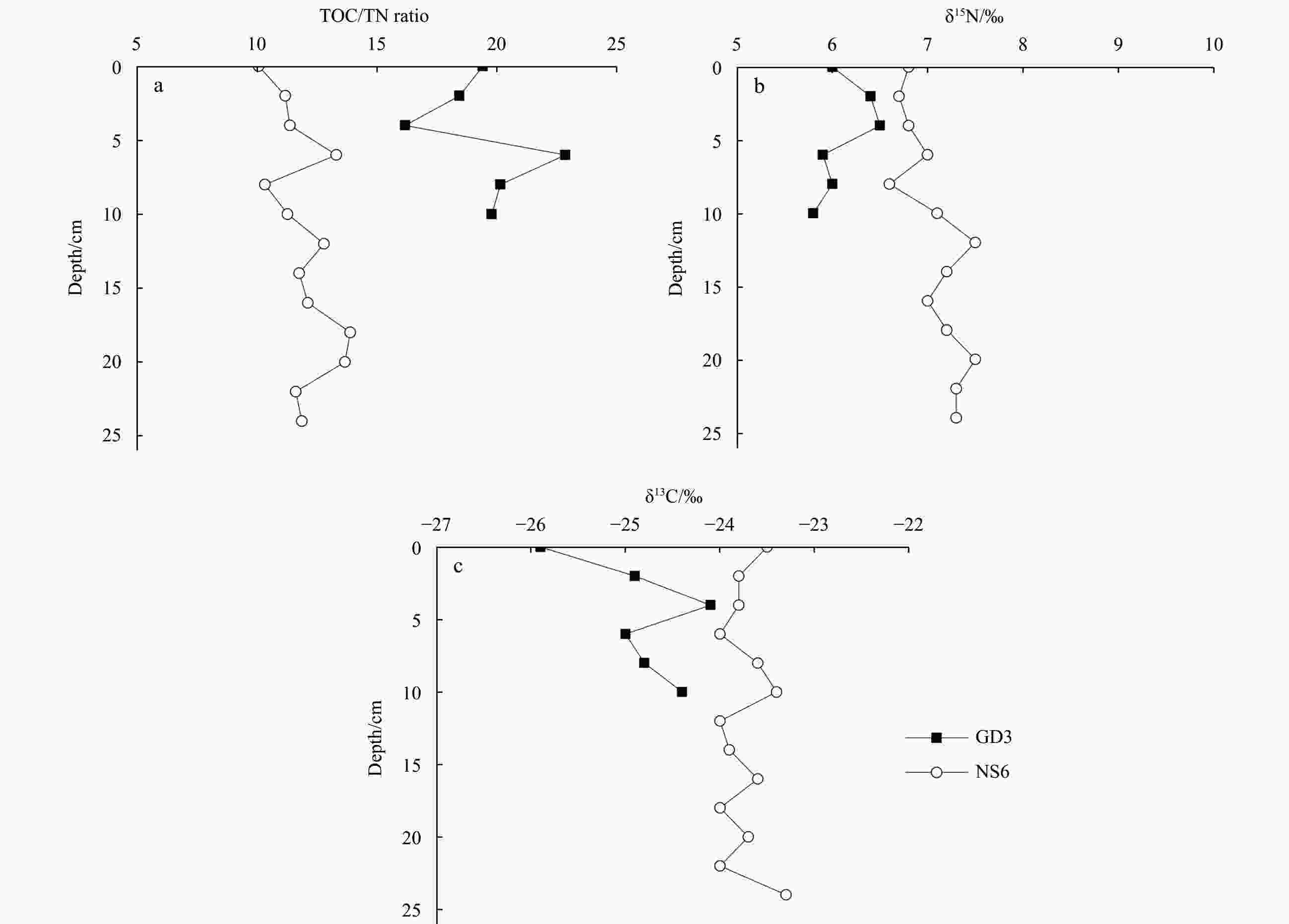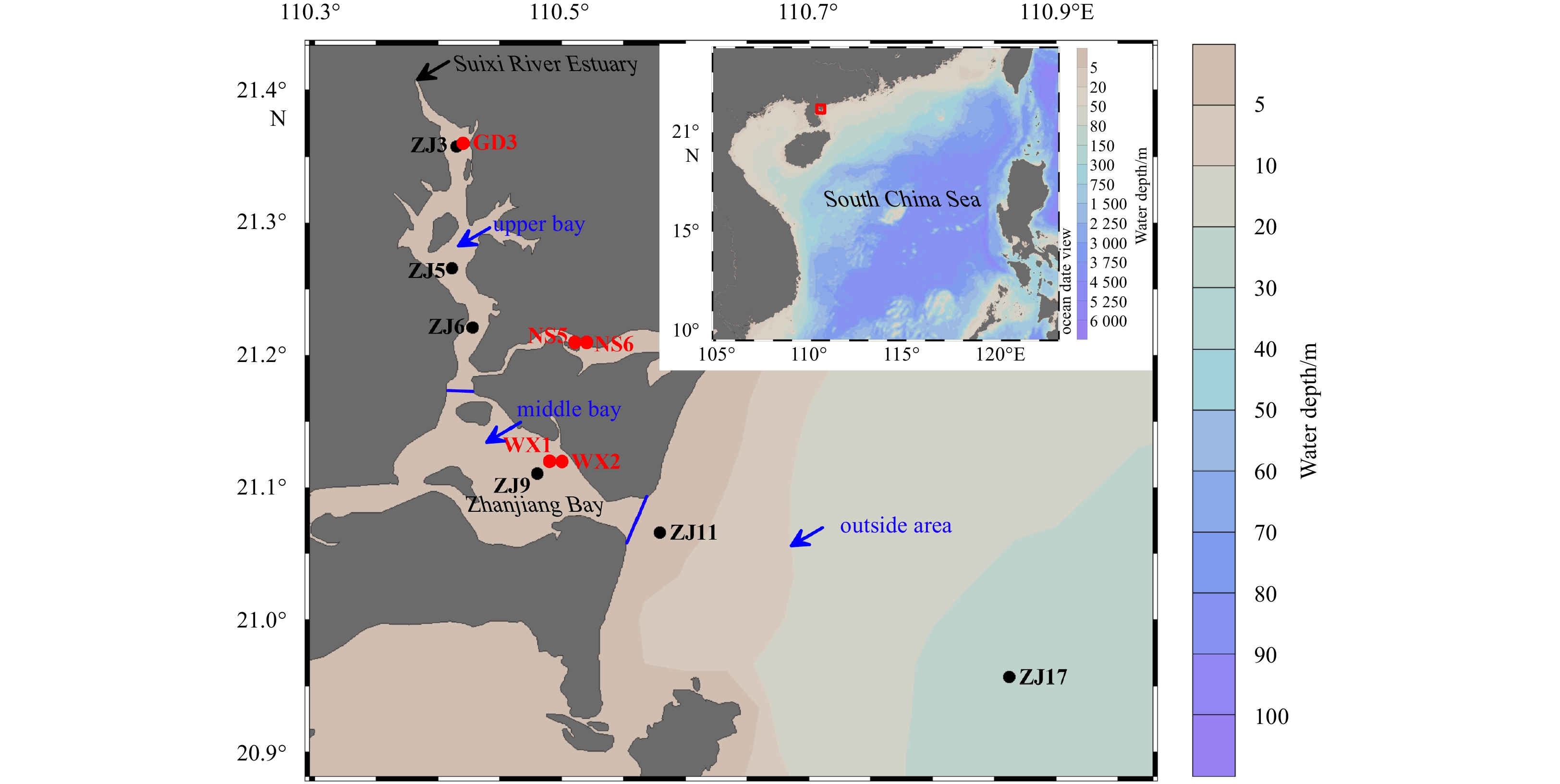Distribution and sources of sedimentary organic matter in different aquaculture areas of northeastern Zhanjiang Bay using stable carbon and nitrogen isotopes
-
Abstract: Zhanjiang Bay is a major aquaculture area in China with many types of mariculture products (such as oysters, fish, and shrimp). The culture area and shrimp output in Zhanjiang Bay are ranked first in China. We investigated the total organic carbon (TOC), total nitrogen (TN), TOC/TN ratio, and stable isotopes (δ13C and δ15N) of the fish and shrimp feed, fish and shrimp feces, and sedimentary organic matter (SOM) in and around different aquaculture areas of northeastern Zhanjiang Bay to study the impact of aquaculture activities on SOM. The average TOC contents of fish and shrimp feed were 39.20% ± 0.91% and 39.29% ± 0.21%, respectively. The average TOC content in the surface sediments of the oyster culture area, the mixed (fish and shrimp) culture area, and the cage fish farm area were 0.66%, 0.88% ± 0.10%, and 0.58% ± 0.19%, respectively, which may indicate that mixed culture had a greater impact on SOM. The relatively high TOC and TN contents and relatively low TOC/TN ratios, and δ15N values in the upper layer of the core sediment in the mixed culture area could also support the significant influence of mixed culture. The average δ13C and δ15N values of fish and shrimp feed were −20.6‰ ± 2.2‰ and 1.8‰ ± 1.2‰, respectively, which were different from the isotopic values of SOM in the study area. δ13C and δ15N values for SOM in different aquaculture areas were different from those of nearby reference stations, probably reflecting the influence of aquaculture. The δ13C and δ15N values in the oyster culture area (−25.9‰ and 6.0‰, respectively) seemed to have reduced δ13C and enriched δ15N relative to those of the reference station (−24.6‰ and 5.8‰, respectively). This may reflect the influence of organic matter on oyster culture. The δ15N value of the station in the mixed culture area (7.1‰ ± 0.4‰) seemed to be relatively enriched in δ15N relative to that of the reference station (6.6‰). Sedimentation and the subsequent degradation of organic matter from mixed cultures may have contributed to this phenomenon. The surface sediment at the cage fish farm area seemed to be affected by fish feces and primary production based on the indication of δ13C and δ15N values. The sediment core at the mixed culture region (NS6) had lower TOC/TN ratios and more positive δ13C and δ15N values than the sediment core at the oyster culture area, suggesting a higher proportionate contribution of marine organic matter in the mixed culture area. In summary, oyster culture, mixed culture, and cage fish culture in northeastern Zhanjiang Bay had a certain degree of impact on SOM, and mixed culture had more significant influences on SOM based on the high TOC contents and the significant vertical variations of TOC/TN ratio and δ15N value in the sediment of this area. This study provides new insights into the impact of aquaculture activities on SOM content.
-
Key words:
- sedimentary organic matter /
- aquaculture /
- stable isotopes /
- sources /
- Zhanjiang Bay
-
Figure 1. Sampling stations in and near Zhanjiang Bay. Stations in red color indicates the stations in aquaculture areas of Zhanjiang Bay. GD3 is located in the oyster culture area; NS5 and NS6 are located in the mixed (fishes and shrimps) culture area; and WX1 and WX2 are located in the cage fish culture area.
Figure 7. The plot of δ13C and δ15N values and δ15N and TOC/TN values for sedimentary organic matter in aquaculture areas (ASOM) and the potential organic matter sources (RSPM: suspended particulate matter from river input; MSPM: suspended particulate matter from marine autogenic; FASF: fish and shrimp feed; FASS: fish and shrimp feces).
Table 1. The carbon and nitrogen contents, δ13C and δ15N values of fish and shrimp feed and feces in the study area
δ13C/‰ δ15N/‰ TOC/% TN/% TOC/TN ratio Fish feed −20.6 ± 2.2 1.8 ± 1.2 39.20 ± 0.91 2.13 ± 0.36 22.0 ± 4.3 Fish fecesa −25.0 6.2 53.10 6.71 9.2 Shrimp feed −18.6 ± 2.6 1.4 ± 0.4 39.29 ± 0.21 2.83 ± 0.62 16.6 ± 3.8 Shrimp fecesa −23.3 4.4 41.76 11.50 4.2 Note: a Due to the small amount of fish and shrimp feces, only one sample of fish feces and one sample of shrimp feces were analyzed. Table 2. The TOC and TN contents, TOC/TN ratio, δ13C and δ15N in surface sediments at each station
Station TOC/% TN/% TOC/TN ratio δ13C/‰ δ15N/‰ GD3 0.66 0.04 19.4 −25.9 6.0 NS5 0.81 0.09 10.6 −23.5 7.3 NS6 0.95 0.11 10.1 −23.5 6.8 WX1 0.44 0.03 19.1 −25.3 7.9 WX2 0.71 0.04 19.1 −24.4 6.8 ZJ3 0.85 0.05 19.3 −24.6 5.8 ZJ5 0.63 0.06 11.3 −24.3 7.5 ZJ6 1.09 0.10 12.7 −24.0 6.6 ZJ9 0.55 0.02 31.3 −25.3 7.8 ZJ11 0.53 0.03 20.2 −27.3 4.2 ZJ17 0.68 0.07 11.6 −23.2 6.2 Table 3. δ13C and δ15N values of samples from different aquaculture areas
Study area Sample type δ13C/‰ δ15N/‰ References Cage fish area in Poyang Lake, China Fish feed −25.1 10.1 Wang et al. (2022) Fish feces −26.3 ± 0.0 14.4 ± 1.6 Wang et al. (2022) Fish farm in Gokasho Bay, Japan Fish feed −20.2 9.7 Yokoyama et al. (2006) Fish feces −24.3 6.3 Yokoyama et al. (2006) Fish farm in Gokasho Bay, Japan Fish feed −21.2 10.4 Yamada et al. (2003) Cage fish area in Nansha Port, China Fish feed −20.38 ± 0.24 6.20 ± 0.13 Jiang et al. (2012) Fish feces −17.57 ± 0.18 7.59 ± 0.34 Jiang et al. (2012) Oyster culture area in Sanggou Bay, China Sediment from oyster −18.49 6.53 Ren et al. (2015) Aquaculture area in Zhanjiang Bay, China Fish feed −20.6 ± 2.2 1.8 ± 1.2 This study Fish feces −25.0 6.2 This study Shrimp feed −18.6 ± 2.6 1.4 ± 0.4 This study Shrimp feces −23.3 4.4 This study Oyster culture area in Zhanjian Bay, China Surface sediment −25.9 6.0 This study Mixed culture area in Zhanjian Bay, China Surface Sediment −23.5 ± 0.0 7.1 ± 0.4 This study Cage fish farm area in Zhanjian Bay, China Surface sediment −24.4 6.8 This study -
Anderson B, Zhang Li, Wang Huining, et al. 2017. Sedimentary carbon and nitrogen dynamics reveal impact of human land-use change on Kawainui Marsh, O‘ahu, Hawai‘i. Pacific Science, 71(1): 17–27, doi: 10.2984/71.1.2 Bouchet V M P, Sauriau P G. 2008. Influence of oyster culture practices and environmental conditions on the ecological status of intertidal mudflats in the Pertuis Charentais (SW France): A multi-index approach. Marine Pollution Bulletin, 56(11): 1898–1912, doi: 10.1016/j.marpolbul.2008.07.010 Bouillon S, Connolly R M, Lee S Y. 2008. Organic matter exchange and cycling in mangrove ecosystems: recent insights from stable isotope studies. Journal of Sea Research, 59(1-2): 44–58, doi: 10.1016/j.seares.2007.05.001 Brandes J A, Devol A H. 2002. A global marine-fixed nitrogen isotopic budget: implications for Holocene nitrogen cycling. Global Biogeochemical Cycles, 16(4): 1120 Chen Fajin, Huang Chao, Lao Qibin, et al. 2021a. Typhoon control of precipitation dual isotopes in southern China and its palaeoenvironmental implications. Journal of Geophysical Research: Atmospheres, 126(14): e2020JD034336, doi: 10.1029/2020JD034336 Chen Fajin, Lu Xuan, Song Zhiguang, et al. 2021b. Coastal currents regulate the distribution of the particulate organic matter in western Guangdong offshore waters as evidenced by carbon and nitrogen isotopes. Marine Pollution Bulletin, 172: 112856, doi: 10.1016/j.marpolbul.2021.112856 Cifuentes L A, Sharp J H, Fogel M L. 1988. Stable carbon and nitrogen isotope biogeochemistry in the Delaware Estuary. Limnology and Oceanography, 33(5): 1102–1115, doi: 10.4319/lo.1988.33.5.1102 Cole M L, Valiela I, Kroeger K D, et al. 2004. Assessment of a δ15N isotopic method to indicate anthropogenic eutrophication in aquatic ecosystems. Journal of Environmental Quality, 33(1): 124–132, doi: 10.2134/jeq2004.1240 Das S K, Routh J, Roychoudhury A N, et al. 2008. Elemental (C, N, H and P) and stable isotope (δ15N and δ13C) signatures in sediments from Zeekoevlei, South Africa: A record of human intervention in the lake. Journal of Paleolimnology, 39(3): 349–360, doi: 10.1007/s10933-007-9110-5 Franco-Nava M A, Blancheton J P, Deviller G, et al. 2004. Particulate matter dynamics and transformations in a recirculating aquaculture system: Application of stable isotope tracers in seabass rearing. Aquacultural Engineering, 31(3-4): 135–155, doi: 10.1016/j.aquaeng.2004.01.003 He Biyan, Dai Minhan, Huang W, et al. 2010. Sources and accumulation of organic carbon in the Pearl River Estuary surface sediment as indicated by elemental, stable carbon isotopic, and carbohydrate compositions. Biogeosciences, 7(10): 3343–3362, doi: 10.5194/bg-7-3343-2010 Jiang Zengjie, Fang Jianguang, Mao Yuze, et al. 2009. Assessment on the sediment quality condition of cage culture area in Nansha Bay. Environmental Science and Management (in Chinese), 34(6): 159–163 Jiang Zengjie, Fang Jianguang, Mao Yuze, et al. 2012. Identification of aquaculture-derived organic matter in the sediment associated with coastal fish farming. Journal of Fishery Sciences of China (in Chinese), 19(2): 348–354 Kaiser D, Unger D, Qiu Guanglong. 2014. Particulate organic matter dynamics in coastal systems of the northern Beibu Gulf. Continental Shelf Research, 82: 99–118, doi: 10.1016/j.csr.2014.04.006 Ke Zhixin, Chen Danting, Liu Jiaxing, et al. 2020. The effects of anthropogenic nutrient inputs on stable carbon and nitrogen isotopes in suspended particulate organic matter in Jiaozhou Bay, China. Continental Shelf Research, 208: 104244, doi: 10.1016/j.csr.2020.104244 Kendall C. 1998. Tracing nitrogen sources and cycling in catchments. In: Kendall C, McDonnell J J, eds. Isotope Tracers in Catchment Hydrology. Amsterdam: Elsevier Science, 519–576 Krishnamurthy R V, Bhattacharya S K, Kusumgar S. 1986. Palaeoclimatic changes deduced from 13C/12C and C/N ratios of Karewa Lake sediments, India. Nature, 323(6084): 150–152, doi: 10.1038/323150a0 La Rosa T, Mirto S, Favaloro E, et al. 2002. Impact on the water column biogeochemistry of a Mediterranean mussel and fish farm. Water Research, 36(3): 713–721, doi: 10.1016/S0043-1354(01)00274-3 Lamb A L, Wilson G P, Leng M J. 2006. A review of coastal palaeoclimate and relative sea-level reconstructions using δ13C and C/N ratios in organic material. Earth-Science Reviews, 75(1–4): 29–57, doi: 10.1016/j.earscirev.2005.10.003 Lao Qibin, Chen Fajin, Jin Guangzhe, et al. 2023a. Characteristics and mechanisms of typhoon-induced decomposition of organic matter and its implication for climate change. Journal of Geophysical Research: Biogeosciences, 128(6): e2023JG007518, doi: 10.1029/2023JG007518 Lao Qibin, Liu Sihai, Ling Zheng, et al. 2023b. External dynamic mechanisms controlling the periodic offshore blooms in Beibu Gulf. Journal of Geophysical Research: Oceans, 128(6): e2023JC019689, doi: 10.1029/2023JC019689 Lao Qibin, Lu Xuan, Chen Fajin, et al. 2023c. A comparative study on source of water masses and nutrient supply in Zhanjiang Bay during the normal summer, rainstorm, and typhoon periods: Insights from dual water isotopes. Science of the Total Environment, 903: 166853, doi: 10.1016/j.scitotenv.2023.166853 Lao Qibin, Wu Junhui, Chen Fajin, et al. 2022a. Increasing intrusion of high salinity water alters the mariculture activities in Zhanjiang Bay during the past two decades identified by dual water isotopes. Journal of Environmental Management, 320: 115815, doi: 10.1016/j.jenvman.2022.115815 Lao Qibin, Zhang Shuwen, Li Zhiyang, et al. 2022b. Quantification of the seasonal intrusion of water masses and their impact on nutrients in the Beibu Gulf using dual water isotopes. Journal of Geophysical Research: Oceans, 127(7): e2021JC018065, doi: 10.1029/2021JC018065 LaZerte B D. 1983. Stable carbon isotope ratios: implications for the source of sediment carbon and for phytoplankton carbon assimilation in Lake Memphremagog Quebec. Canadian Journal of Fisheries and Aquatic Sciences, 40(10): 1658–1666, doi: 10.1139/f83-192 Li Jiacheng, Cao Ruixue, Lao Qibin, et al. 2020. Assessing seasonal nitrate contamination by nitrate dual isotopes in a monsoon-controlled bay with intensive human activities in South China. International Journal of Environmental Research and Public Health, 17(6): 1921, doi: 10.3390/ijerph17061921 Liao Weisen, Hu Jianfang, Zhou Haoda, et al. 2018. Sources and distribution of sedimentary organic matter in the Beibu Gulf, China: Application of multiple proxies. Marine Chemistry, 206: 74–83, doi: 10.1016/j.marchem.2018.09.006 Liu Jingjing. 2019. Sources of sedimentary organic matter in and around cage fish farming of Poyang Lake using stable carbon and nitrogen isotopes (in Chinese) [dissertation]. Nanchang: Nanchang University Liu Guofeng, Xu Pao, Wu Ting, et al. 2018. Present condition of aquaculture nitrogen and phosphorus environmental pollution and future development strategy. Jiangsu Journal of Agricultural Sciences (in Chinese), 34(1): 225–233 Liu Sai, Yang Qian, Yang Shu, et al. 2014. The long-term records of carbon burial fluxes in sediment cores of culture zones from Sanggou Bay. Haiyang Xuebao (in Chinese), 36(8): 30–38 Lu Xuan, Zhou Fengxia, Chen Fajin, et al. 2020. Spatial and seasonal variations of sedimentary organic matter in a subtropical bay: Implication for human interventions. International Journal of Environmental Research and Public Health, 17(4): 1362, doi: 10.3390/ijerph17041362 Lu Xuan, Zhou Xin, Jin Guangzhe, et al. 2022. Biological impact of Typhoon Wipha in the coastal area of western Guangdong: A comparative field observation perspective. Journal of Geophysical Research: Biogeosciences, 127(2): e2021JG006589, doi: 10.1029/2021JG006589 McGhie T K, Crawford C M, Mitchell I M, et al. 2000. The degradation of fish-cage waste in sediments during fallowing. Aquaculture, 187(3-4): 351–366, doi: 10.1016/S0044-8486(00)00317-3 Meyers P A. 1997. Organic geochemical proxies of paleoceanographic, paleolimnologic, and paleoclimatic processes. Organic Geochemistry, 27(5-6): 213–250, doi: 10.1016/S0146-6380(97)00049-1 Miyake Y, Wada E. 1971. The isotope effect on the nitrogen in biological, oxidation-reduction-reactions. Records of Oceanographic Works in Japan, 11: 1–6 Pan Zhe, Gao Qinfeng, Dong Shuanglin, et al. 2019. Effects of abalone (Haliotis discus hannai Ino) and kelp (Saccharina japonica) mariculture on sources, distribution, and preservation of sedimentary organic carbon in Ailian Bay, China: Identified by coupling stable isotopes (δ13C and δ15N) with C/N ratio analyses. Marine Pollution Bulletin, 141: 387–397, doi: 10.1016/j.marpolbul.2019.02.053 Pancost R D, Boot C S. 2004. The palaeoclimatic utility of terrestrial biomarkers in marine sediments. Marine Chemistry, 92(1-4): 239–261, doi: 10.1016/j.marchem.2004.06.029 Redfield A C, Ketchum B H, Rechards F A. 1963. The influence of organisms on the composition of seawater. In: Hill M N, ed. The Composition of Sea-Water, Comparative and Descriptive Oceanography. New York: Wiley Interscience, 26–27 Ren Lihua, Zhang Jihong, Niu Yali, et al. 2015. Stable isotope evidence for the sediment impacts on biodeposits from long-line cultured Crassostrea gigas in Sungo Bay. Marine Sciences (in Chinese), 39(11): 79–85 Rubio-Portillo E, Villamor A, Fernandez-Gonzalez V, et al. 2019. Exploring changes in bacterial communities to assess the influence of fish farming on marine sediments. Aquaculture, 506: 459–464, doi: 10.1016/j.aquaculture.2019.03.051 Sarkar A, Chakraborty P, Nath B N. 2016. Distribution and nature of sedimentary organic matter in a tropical estuary: An indicator of human intervention on environment. Marine Pollution Bulletin, 102(1): 176–186, doi: 10.1016/j.marpolbul.2015.11.013 Schubert C J, Calvert S E. 2001. Nitrogen and carbon isotopic composition of marine and terrestrial organic matter in Arctic Ocean sediments: implications for nutrient utilization and organic matter composition. Deep-Sea Research Part I: Oceanographic Research Papers, 48(3): 789–810, doi: 10.1016/S0967-0637(00)00069-8 Srithongouthai S, Tada K. 2017. Impacts of organic waste from a yellowtail cage farm on surface sediment and bottom water in Shido Bay (the Seto Inland Sea, Japan). Aquaculture, 471: 140–145, doi: 10.1016/j.aquaculture.2017.01.021 Talbot M R, Livingstone D A. 1989. Hydrogen index and carbon isotopes of lacustrine organic matter as lake level indicators. Palaeogeography, Palaeoclimatology, Palaeoecology, 70(1–3): 121–137 Wada E, Hattori A. 1991. Nitrogen in the Sea: Forms, Abundances, and Rate Processes. Boca Raton, FL: CRC Press Wang Maolan, Lai Jianping, Hu Ketu, et al. 2014. Compositions and sources of stable organic carbon and nitrogen isotopes in surface sediments of Poyang Lake. China Environmental Science (in Chinese), 34(4): 1019–1025 Wang Maolan, Zhao Liyue, Wan Yangjie, et al. 2022. Tracing the organic matter source of cage culture sediments based on stable carbon and nitrogen isotopes in Poyang Lake, China. Marine Pollution Bulletin, 182: 113943, doi: 10.1016/j.marpolbul.2022.113943 Wu Xiaoyi, Yang Yufeng. 2011. Heavy metal (Pb, Co, Cd, Cr, Cu, Fe, Mn and Zn) concentrations in harvest-size white shrimp litopenaeus vannamei tissues from aquaculture and wild source. Journal of Food Composition and Analysis, 24(1): 62–65, doi: 10.1016/j.jfca.2010.03.030 Yamada Y, Yokoyama H, Ishihi Y, et al. 2003. Historical feeding analysis in fish farming based on carbon and nitrogen stable isotope ratio in sediment. Fisheries Science, 69(1): 213–215, doi: 10.1046/j.1444-2906.2003.00609.x Ye Lixun, Ritz D A, Fenton G E, et al. 1991. Tracing the influence on sediments of organic waste from a salmonid farm using stable isotope analysis. Journal of Experimental Marine Biology & Ecology, 145(2): 161–174 Yokoyama H, Abo K, Ishihi Y. 2006. Quantifying aquaculture-derived organic matter in the sediment in and around a coastal fish farm using stable carbon and nitrogen isotope ratios. Aquaculture, 254(1-4): 411–425, doi: 10.1016/j.aquaculture.2005.10.024 Zhang Caixue, Lin Hongsheng, Sun Xingli. 2012. Source and distribution of organic matter in surface sediments of a typical bay in Guangdong Province, China. Journal of Tropical Oceanography (in Chinese), 31(6): 62–68 Zhang Ling, Yin Kedong, Wang Lu, et al. 2009. The sources and accumulation rate of sedimentary organic matter in the Pearl River Estuary and adjacent coastal area, Southern China. Estuarine, Coastal and Shelf Science, 85(2): 190–196 Zhou Fengxia, Gao Xuelu, Yuan Huamao, et al. 2018. The distribution and seasonal variations of sedimentary organic matter in the East China Sea shelf. Marine Pollution Bulletin, 129(1): 163–171, doi: 10.1016/j.marpolbul.2018.02.009 Zhou Xin, Jin Guangzhe, Li Jiacheng, et al. 2021. Effects of typhoon Mujigae on the biogeochemistry and ecology of a Semi-Enclosed Bay in the Northern South China Sea. Journal of Geophysical Research: Biogeosciences, 126(7): e2020JG006031, doi: 10.1029/2020JG006031 Zhuang Yanpei, Li Yangjie, Chen Ling, et al. 2023. Biogeochemical and physical controls on ammonium accumulation on the Chukchi shelf, western Arctic Ocean. Marine Environmental Research, 190: 106084, doi: 10.1016/j.marenvres.2023.106084 -





 下载:
下载:









